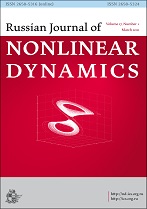|
Mathematical problems of nonlinearity
Modeling the Learning of a Spiking Neural Network with Synaptic Delays
A. S. Migalev, P. M. Gotovtsev
National Research Center “Kurchatov Institute”,
pl. Akademika Kurchatova 1, Moscow, 123182 Russia
Аннотация:
This paper addresses the spiking (or pulsed) neural network model with synaptic time delays at dendrites. This model allows one to change the action potential generation time more precisely with the same input activity pattern. The action potential time control principle proposed previously by several researchers has been implemented in the model considered. In the neuron model the required excitatory and inhibitory presynaptic potentials are formed by weight coefficients with synaptic delays. Various neural network architectures with a long-term plasticity model are investigated. The applicability of the spike-timing-dependent plasticity based learning rule (STDP) to a neuron model with synaptic delays is considered for a more accurate positioning of action potential time. Several learning protocols with a reinforcement signal and induced activity using varieties of functions of weight change (bipolar STDP and Ricker wavelet) are used. Modeling of a single-layer neural network with the reinforcement signal modulating the weight change function amplitude has shown a limited range of available output activity. This limitation can be bypassed using the induced activity of the output neuron layer during learning. This modification of the learning protocol allows reproducing more complex output activity, including for multiple layered networks. The ability to construct desired activity on the network output on the basis of a multichannel input activity pattern was tested on single and multiple layered networks. Induced activity during learning for networks with feedback connections allows one to synchronize multichannel input spike trains with required network output. The application of the weight change function leads to association of input and output activity by the network. When the induced activity is turned off, this association, configuration on the required output, remains. Increasing the number of layers and reducing feedback connection leads to weakening of this effect, so that additional mechanisms are required to synchronize the whole network.
Ключевые слова:
pulsed neural network model, spiking neural network model, synaptic plasticity, synchronization, induced activity, time delayed synapses.
Поступила в редакцию: 16.01.2019
Принята в печать: 06.07.2019
Образец цитирования:
A. S. Migalev, P. M. Gotovtsev, “Modeling the Learning of a Spiking Neural Network with Synaptic Delays”, Rus. J. Nonlin. Dyn., 15:3 (2019), 365–380
Образцы ссылок на эту страницу:
https://www.mathnet.ru/rus/nd666 https://www.mathnet.ru/rus/nd/v15/i3/p365
|

| Статистика просмотров: |
| Страница аннотации: | 238 | | PDF полного текста: | 64 | | Список литературы: | 30 |
|




 Обратная связь:
Обратная связь: Пользовательское соглашение
Пользовательское соглашение
 Регистрация посетителей портала
Регистрация посетителей портала Логотипы
Логотипы








 Цитирование в формате
Цитирование в формате 